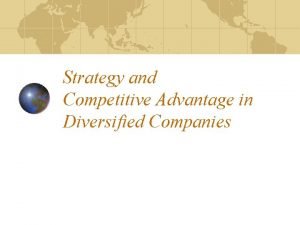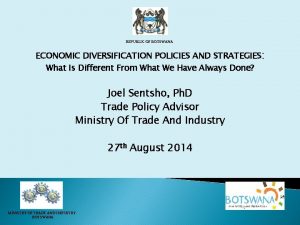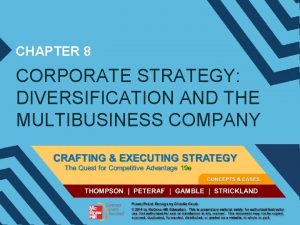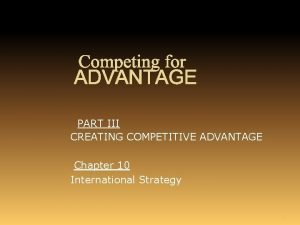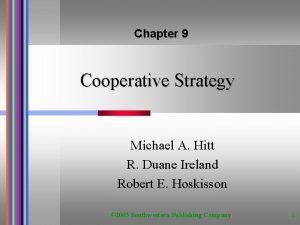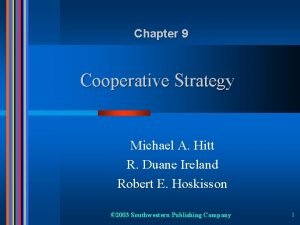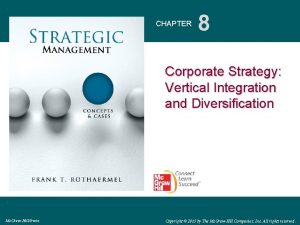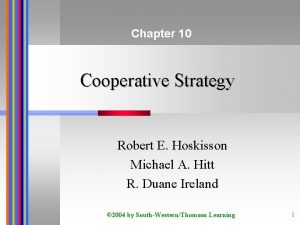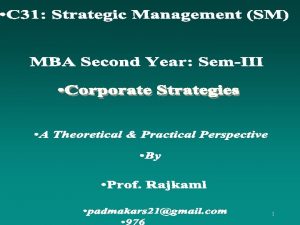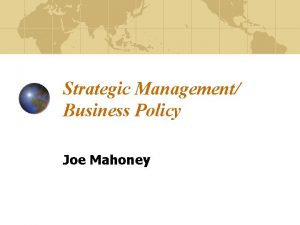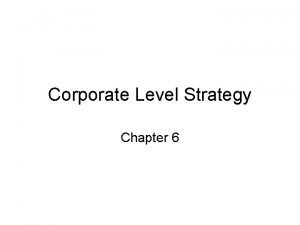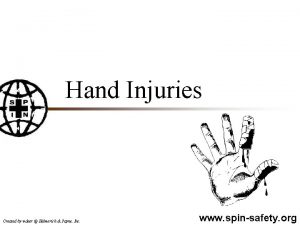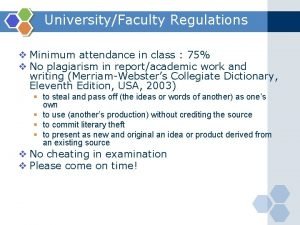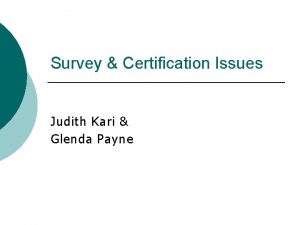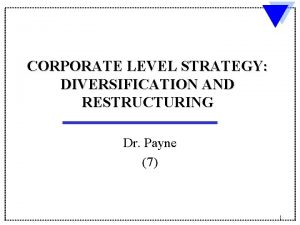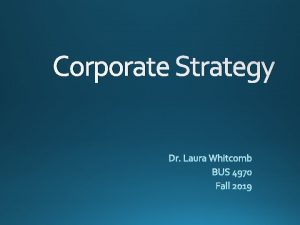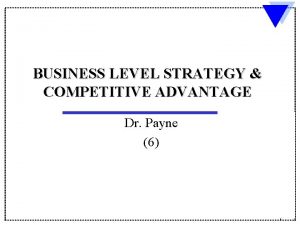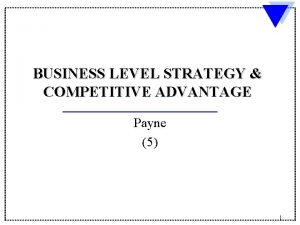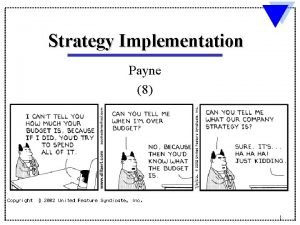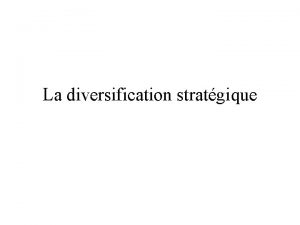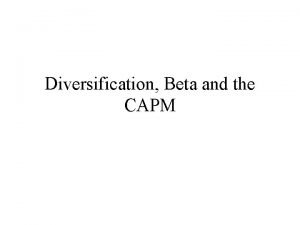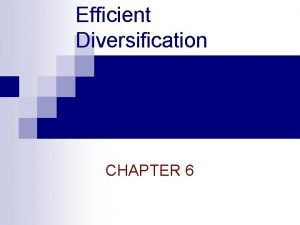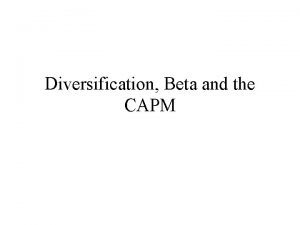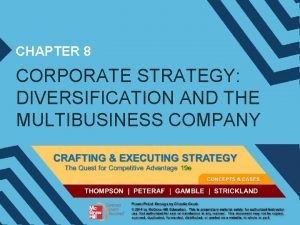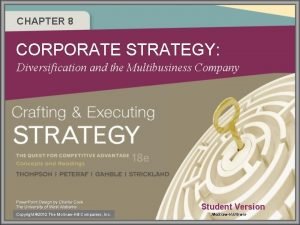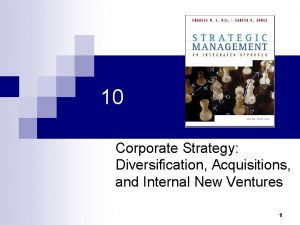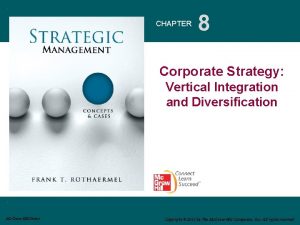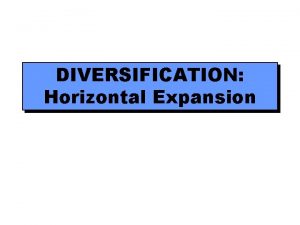CORPORATE LEVEL STRATEGY DIVERSIFICATION Dr Payne 8 1

































- Slides: 33

CORPORATE LEVEL STRATEGY & DIVERSIFICATION Dr. Payne (8) 1

Corporate Strategy • “Diversified” = two or more lines of business • Strategy-making in a diversified company is a bigger picture exercise than crafting a strategy for a single lineof-business A diversified company needs a multi-industry, multi-business strategy – A strategic action plan must be developed for several different businesses competing in diverse industry environments – • Main Tasks in Corporate Strategy: – – Make moves to enter new businesses Initiate actions to boost combined performance of businesses Find ways to capture synergy among related business units Establish investment priorities, steering resources into most attractive business units 2

Motives for Diversification GROWTH -- The desire to escape stagnant or declining industries a powerful motives for diversification (e. g. tobacco, oil, newspapers). -- But, growth satisfies managers not shareholders. -- Growth strategies (esp. by acquisition), tend to destroy shareholder value RISK SPREADING -- Diversification reduces variance of profit flows -- But, doesn’t create value for shareholders—they can hold diversified portfolios of securities. -- Capital Asset Pricing Model shows that diversification lowers unsystematic risk not systematic risk. PROFIT -- For diversification to create shareholder value, then bringing together of different businesses under common ownership & must somehow increase their profitability. 3

Competitive Advantage from Diversification MARKET POWER ECONOMIES OF SCOPE • Predatory pricing • Reciprocal buying • Mutual forbearance Evidence of these is sparse • Sharing tangible resources (research labs, distribution systems) across multiple businesses • Sharing intangible resources (brands, technology) across multiple businesses • Transferring functional capabilities (marketing, product development) across businesses • Applying general management capabilities to multiple businesses • Economies of scope not a sufficient basis for diversification— ECONOMIES must be supported by transaction costs • Diversification firm can avoid transaction costs by operating FROM INTERNALIZING internal capital and labor markets TRANSACTIONS • Key advantage of diversified firm over external markets--superior access to information 4

The Decision Logic of Strategy Formulation May be Corporate or Business Strategic Decisions Establishment of mission, vision, values, objectives -- the Directional Strategies Identification, evaluation, and selection of -- the Adaptive Strategies Identification, evaluation, and selection of -- the Market Entry Strategies Identification, evaluation, and selection of -- the Positioning Strategies Implementation through development of -- the Functional & Operational Strategies 5

Adaptive Strategies • Delineate how the organization will adapt to changes in the environment or competitive landscape: Expansion • Diversification • Vertical Integration • Market Development • Product Development • Penetration Contraction • Divestiture • Liquidation • Harvesting • Retrenchment • Outsourcing Stabilization • Enhancement • Status Quo Corporate Strategy Decisions Only 6

Adaptive: Expansion-Diversification • When markets outside the organizations core business offer potential for substantial growth. • Considered risky, because entering an unfamiliar market or offering a product/service that is different. – Related Diversification (related-constrained, related-linked) is when the organization chooses a market to enter that is similar to its present operations. • Clothing manufacture entering into the shoe market. • Hospital buying a physician practice. – Unrelated Diversification is when the market chosen to enter is dissimilar, sometimes intended to create a portfolio of separate products/service. • Clothing manufacturer entering into the electronics market. • Hospital building an office building for rental space. 7

Related Diversification • Competitive advantage can result from related diversification if opportunities exist to: Transfer expertise/capabilities/technology Combine related activities into a single operation and reduce costs – Leverage use of firm’s brand name reputation – Conduct related value chain activities in a collaborative fashion to create valuable competitive capabilities – – • Approaches: Sharing of sales force, advertising, or distribution activities Exploiting closely related technologies Transferring know-how / expertise from one business to another – Transferring brand name and reputation to a new product/service – Acquiring new businesses to uniquely help firm’s position in 8 existing businesses – – –

Levels and Types of Diversification Low Single Business > 95% of business from a single business unit Dominant Business Between 70 and 95% of business from a single business unit Related Constrained <70% of revenues from dominant business; all businesses share product, technological and distribution linkages Related Linked (Mixed Related and Unrelated) < 70% of revenues from dominant business and only limited links exist Very Unrelated High < 70% of revenue comes from the dominant business, and there are no common links between businesses 9

Cooperative Form of Multidivisional Structure: Related-Constrained Strategy Headquarters Office President Government Affairs Legal Affairs Corporate R&D Lab Strategic Planning Corporate Human Resources Product Division Corporate Marketing Corporate Finance Product Division 10

Cooperative Form of Multidivisional Structure: Related-Constrained Strategy • Structural integration devices create tight links among all divisions • Corporate office emphasizes centralized strategic planning, human resources, and marketing to foster cooperation between divisions • R&D is likely to be centralized • Rewards are subjective and tend to emphasize overall corporate performance, in addition to divisional performance • Culture emphasizes cooperative sharing 11

SBU Form of Multidivisional Structure: Related-Linked Strategy Headquarters Office Corporate R&D Lab President Strategic Planning Corporate HRM SBU Division Corporate Marketing Corporate Finance SBU Division Division 12

SBU Form of Multidivisional Structure: Related-Linked Strategy • Structural integration among divisions within SBUS, but independents across SBUs • Strategic planning may be the most prominent function in headquarters for managing the strategic planning approval process of SBUs for the president. • Each SBU may have its own budget for staff to foster integration. • Corporate headquarters staff serve as consultants to SBUs and divisions, rather than having direct input to product strategy, as in the cooperative form. 13

Competitive Form of Multidivisional Structure: Unrelated Diversification Strategy • Corporate headquarters has a small staff • Finance and auditing are the most prominent functions in the headquarters to manage cash flow and ensure the accuracy of performance data coming from divisions • The legal affairs function becomes important when the firm acquires or divests assets • Divisions are independent and separate for financial evaluation purposes • Divisions retain strategic control, but cash is managed by the corporate office • Divisions compete for corporate resources 14

Competitive Form of Multidivisional Structure: Unrelated Diversification Strategy Headquarters Office President Legal Affairs Finance Division Auditing Division 15

Appeal / Drawbacks of Unrelated Diversification • Appeal: – Business risk scattered over different industries – Capital resources can be directed to those industries offering best profit prospects – Stability of profits -- Hard times in one industry may be offset by good times in another industry – If bargain-priced firms with big profit potential are bought, shareholder wealth can be enhanced • Drawbacks: – Difficulties of competently managing many diverse businesses – There are typically no strategic fits which can be leveraged into competitive advantage • Consolidated performance of unrelated businesses tends to be no better than sum of individual businesses on their own (and it may be worse) • Promise of greater sales-profit stability over business cycles seldom realized 16

Unrelated Diversification • Involves diversifying into businesses with: – – – No strategic fit No meaningful value chain relationships No unifying strategic theme Approach is to venture into “any business in which we think we can make a profit” • Firms pursuing unrelated diversification are often referred to as conglomerates • Attractive Targets: • – Companies with undervalued assets • – Companies in financial distress • – Capital gains may be realized May be purchased at bargain prices and turned around Companies with bright prospects but limited capital Any company that can be acquired on good financial terms and offers good prospects for profitability is a good business to diversify into! 17

Entering New Industries • Acquisition - Most popular approach to diversification • • Joint Venture Advantages: Advantages – Quicker entry into target market – Easier to hurdle certain entry barriers – Technological inexperience – Gaining access to reliable suppliers – Size to match rivals in terms of efficiency – Getting adequate distribution access • Good way to diversify when: Uneconomical or risky to go it alone – Pooling competencies of two partners and costs provides more competitive strength New Internal Business – Foreign partners are More attractive when: needed to surmount –Ample time exists to create new business from ground up • Import quotas –Incumbents slow in responding to new entry • Tariffs –Less expensive than acquiring an existing firm • Nationalistic –Company already has most of needed skills political interests –Additional capacity will not adversely impact supply • Cultural roadblocks demand balance in industry – –New start-up does not have to go head-to-head against powerful rivals 18

M&A Activity • M&As are common ways to grow and diversify the organization. Activity comes in waves. 19

Premiums Paid Give Target More Value 20

Reasons for Failure (~50%) 21

Extent of Investment and Risk Entry Modes for Expansion High Wholly Owned Subsidiary Joint Venture Strategic Alliance Franchising Licensing Exporting Low High Degree of Ownership and Control 22

Adaptive: Expansion-Vertical Integration Vertical integration extends a firm’s competitive scope within same industry Ø Backward (upstream) into sources of supply Ø Forward (downstream) toward end-users of final product/service l Can aim at either full or partial integration l Plastics Producer / Medical Device Marketer or Retail Store (e. g. , Machinery Provider Manufacturer Distributor Walgreens) Vertical Backward Integration Forward Activities, Costs, & Margins of Suppliers Internally Performed Activities, Costs, & Margins of Forward Channel Allies & Strategic Partners Buyer/User Value Chains 23

Benefits and Cost of VI Benefits Costs • Technical economies from • Differences in optimal scale of integrating processes e. g. iron operation between different stages prevents balanced VI and steel production • Strategic differences between • Superior coordination different vertical stages creates • Avoids transactions costs of management difficulties market contracts in situations • Inhibits development and where there are: exploitation of core -- small numbers of firms competencies -- transaction-specific investments • Limits flexibility -- opportunism and strategic -- in responding to demand cycles misrepresentation -- taxes and regulations on market transactions -- in responding to changes in technology, customer preferences, etc. 24

When to Diversify Strong Weak Rapid Strong competitive position, rapid market growth -- Not a good time to diversify Weak competitive position, rapid market growth -- Not a good time to diversify Slow Market Growth Competitive Position Strong competitive position, slow market growth -- Diversification is top priority consideration Weak competitive position, slow market growth -Diversification merits consideration 25

Adaptive: Contraction Strategies Decrease the size & scope of operations: • Divestiture - operating strategic unit (or entire business) is sold as a result of a decision to permanently and completely leave the market. • Liquidation - selling the assets of an organization, which cannot be sold as a viable and operational organization (assets still have value, but not the business). • Harvesting - reaping maximum short-term benefits riding a longterm decline in the market. • Retrenchment - response to declining profitability usually brought about by increasing costs - needs redefinition of target market, selective cost elimination, and asset reduction. • Outsourcing - Involves not performing certain value chain activities internally and relying on outside vendors to perform needed activities and services. 26

Decision Tool 1: Evaluating Competitive Strength Different Business Units Objectives: – Determine how well each business is positioned in its industry relative to rivals – Evaluate whether it is or can be competitively strong enough to contend for market leadership Competitive Strength Factors: Relative market share Ability to compete on cost Ability to match rivals on quality and/or service Ability to exercise bargaining leverage with suppliers or customers Technology and innovation capabilities How well business unit’s competitive assets and competencies match industry KSFs • Brand name recognition and reputation • Profitability relative to competitors • • • 27

Constructing an Attractiveness / Strength Matrix Use quantitative measures of industry attractiveness and business strength (remember the weighted vs. unweighted attractiveness matrices? ) to plot location of each business in matrix • Each business unit appears as a circle: • – Area of circle is proportional to size of business as a percent of company revenues (Or area of circle can represent relative size of industry with pie slice showing the company’s market share) Large portion of total revenue for company Small portion of total revenue for company Company holds ~ 25% of total market share available in large industry 25% 28

Representative Nine-Cell Industry Attractiveness-Business Strength Matrix Business Strength Industry Attractiveness • Market Size • Growth Rate • Profit Margin • Intensity of Competition • Seasonality • Cyclicality • Resource Requirements • Social Impact • Regulation • Environment • Opportunities & Threats • Relative Market Share • Relative Costs • Reputation/ Image • Profit Margins • Bargaining Leverage • Fit with KSFs • Ability to Match Quality/Service 10. 0 Strong 6. 7 Average 3. 3 Weak 1. 0 High 6. 7 Medium 3. 3 Low 1. 0 High Priority - Grow Medium Priority - Maintain Low Priority - Divest 29

Decision Tool 2: Assessing Strategic Fit • Objective – • Determine competitive advantage potential of value chain relationships and strategic fits among current businesses Examine fit needs from two angles: Whether one or more businesses have valuable strategic fit with other businesses in portfolio – Whether each business meshes well with firm’s longterm strategic direction – 30

Identifying Strategic Fits Among a Diversified Firm’s Business Units Value Chain Activities Inbound Logistics Technology Operations Sales and Marketing Distribution Service Business A Business B Business C Business D Business E Opportunity to combine purchasing activities & gain greater leverage with suppliers Opportunity to share technology, transfer technical skills, combine R&D Opportunity to combine sales & marketing activities, use common distribution channels, leverage use of a common brand name, and/or combine after-sale service No strategic fit opportunities 31

Decision Tool 3: Assessing Resources Objective: – Determine how well firm’s resources match business unit requirements • Good resource fit exists when: – Businesses add to a firm’s resource strengths, either financially or strategically – Firm has (financial) resources to adequately support requirements of its businesses as a group 32

Dogs to Hogs: Assessing Cash Flow between Businesses l Determine cash flow and investment requirements of the business units - Are they cash hogs or cash cows? A business is a cash hog when its internal cash flows are inadequate to fully fund its need for working capital and new capital investment the parent company has to continually pump in capital to “feed the hog” Strategic options: invest in attractive cash hogs (question High Growth marks or stars) 4 Divest cash hogs (dogs, maybe question marks) Slow lacking long-term potential High Share Low Share Star Question Mark 4 Aggressively Growth Cash Flow l ? ow l h. F s Ca Cash Flow Cow Dog Bark!! 33
 Corporate strategy and business strategy
Corporate strategy and business strategy Directional strategies in strategic management
Directional strategies in strategic management Samsung unrelated diversification strategy
Samsung unrelated diversification strategy Competitive advantage in diversified companies
Competitive advantage in diversified companies Economic diversification drive strategy botswana
Economic diversification drive strategy botswana Volkswagen diversification strategy
Volkswagen diversification strategy Cross business strategic fit
Cross business strategic fit Organizational strategy types
Organizational strategy types Strategy map hr scorecard digital dashboard
Strategy map hr scorecard digital dashboard A multidomestic corporate-level strategy is one in which:
A multidomestic corporate-level strategy is one in which: Corporate level cooperative strategy
Corporate level cooperative strategy Corporate level cooperative strategy
Corporate level cooperative strategy Vertical integration
Vertical integration Functional level strategy in strategic management
Functional level strategy in strategic management Corporate level cooperative strategy
Corporate level cooperative strategy Formulating corporate level strategy
Formulating corporate level strategy Types of corporate level strategy
Types of corporate level strategy A transnational corporate-level strategy seeks to achieve
A transnational corporate-level strategy seeks to achieve Types of corporate level strategies
Types of corporate level strategies Chase demand strategy formula
Chase demand strategy formula Corporate finance objectives
Corporate finance objectives Ruby payne hidden rules chart
Ruby payne hidden rules chart Helmerich and payne point store
Helmerich and payne point store Bernard l shaw
Bernard l shaw Slocumb-payne teacher perception inventory
Slocumb-payne teacher perception inventory Ruby payne framework for understanding poverty
Ruby payne framework for understanding poverty Idic model example
Idic model example Elementary is talented
Elementary is talented Glenda payne
Glenda payne Elinor payne
Elinor payne Payne junior high
Payne junior high Risi kondor
Risi kondor Max payne
Max payne Malcolm payne group
Malcolm payne group



